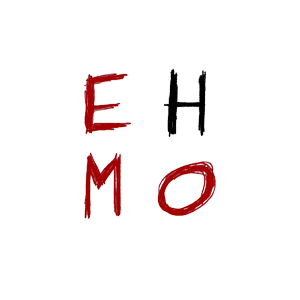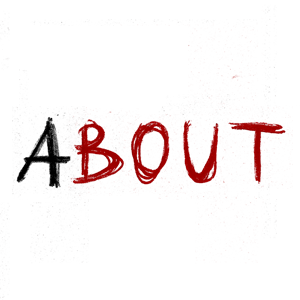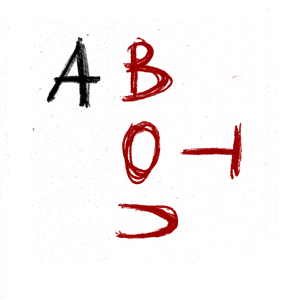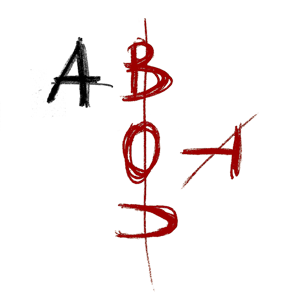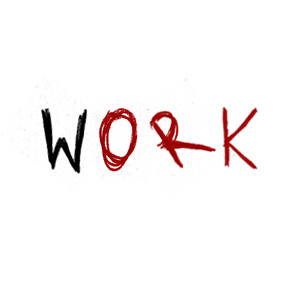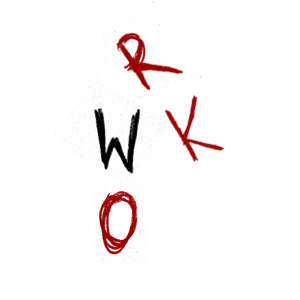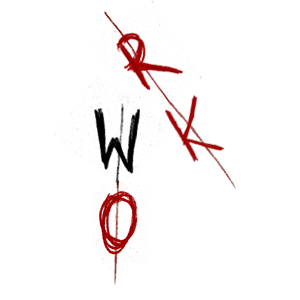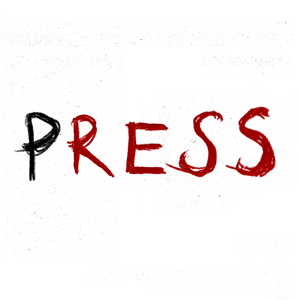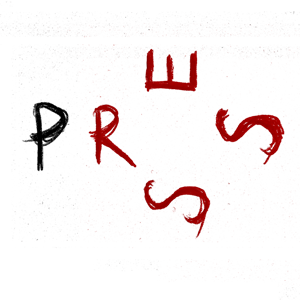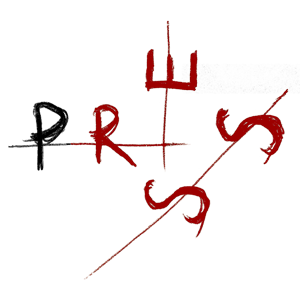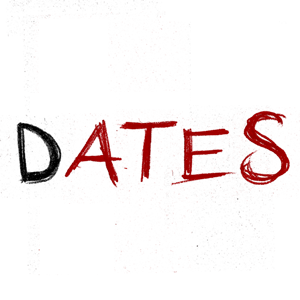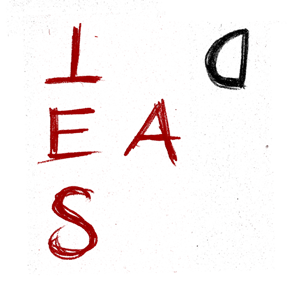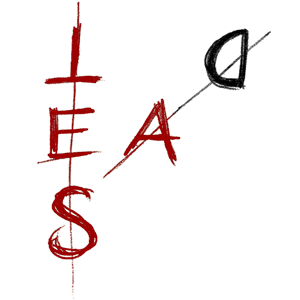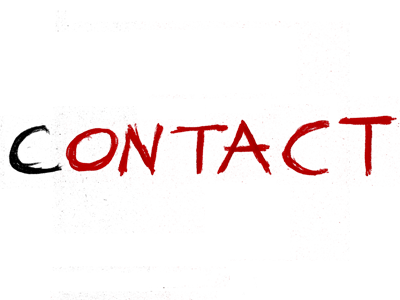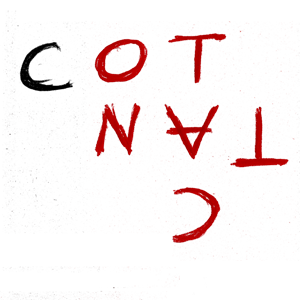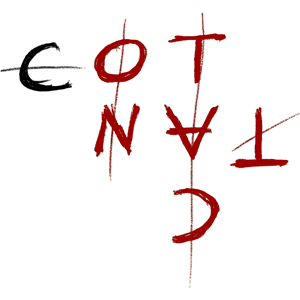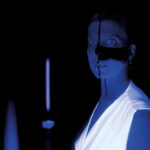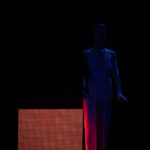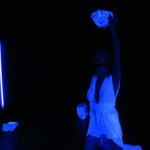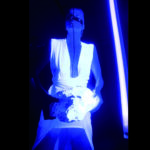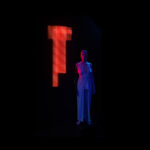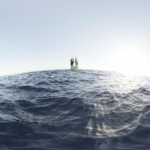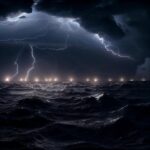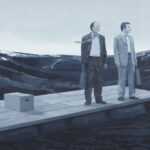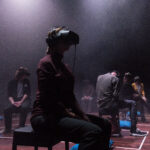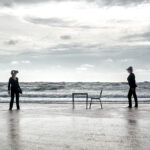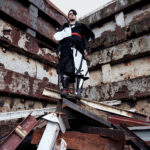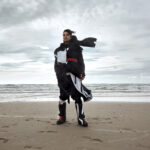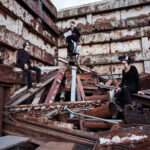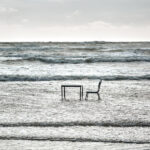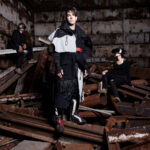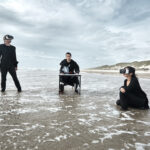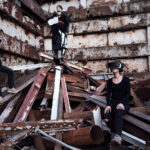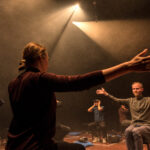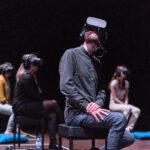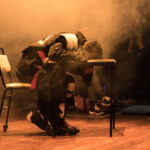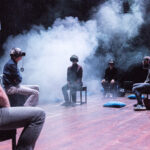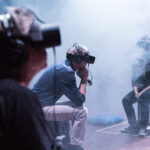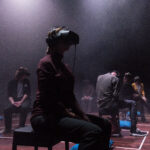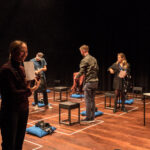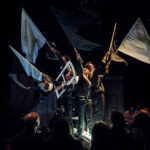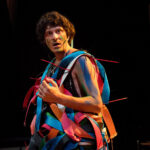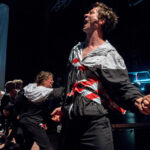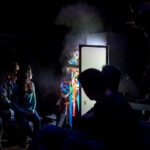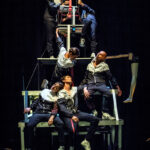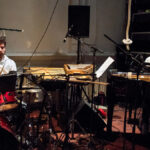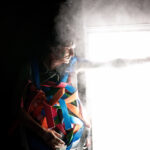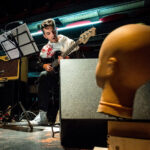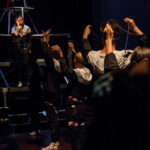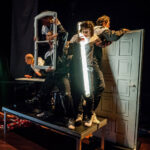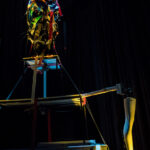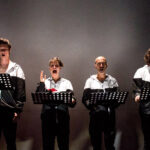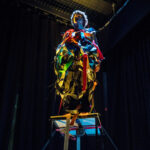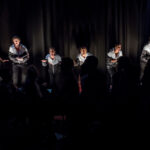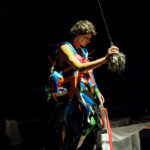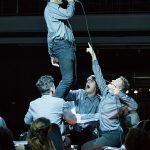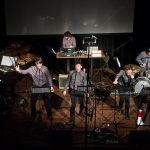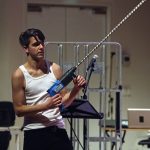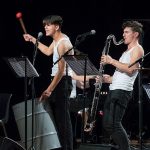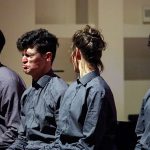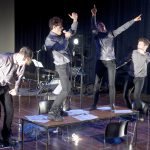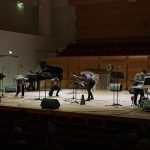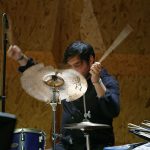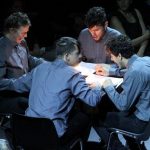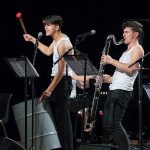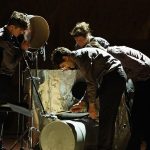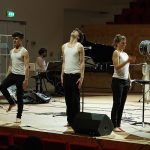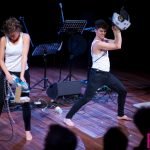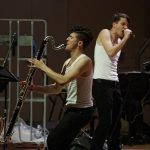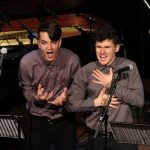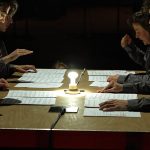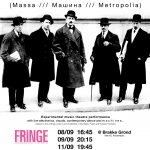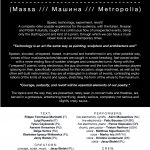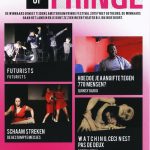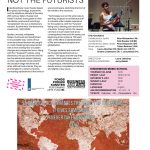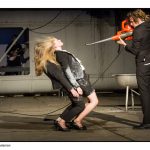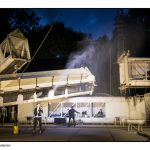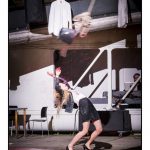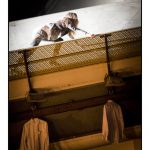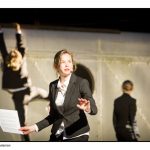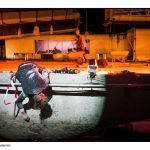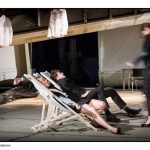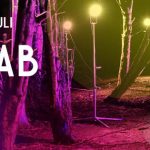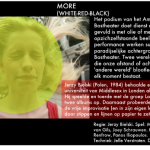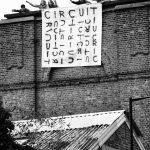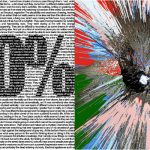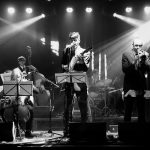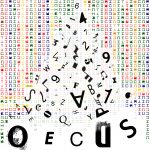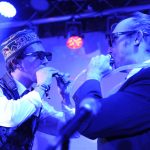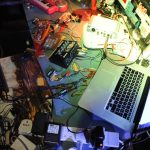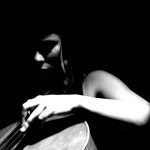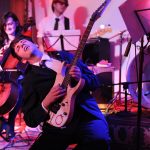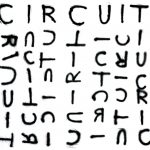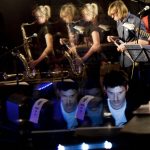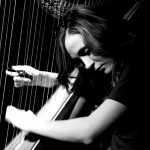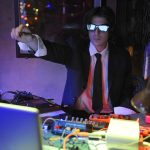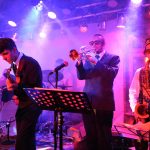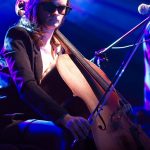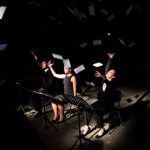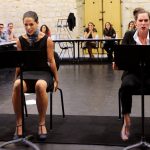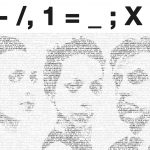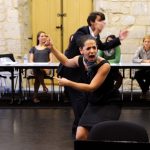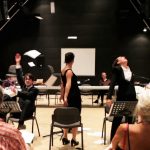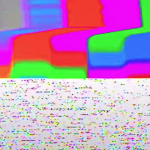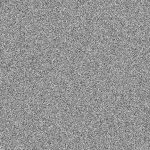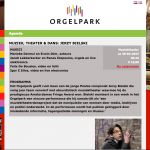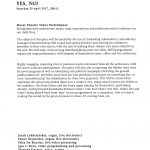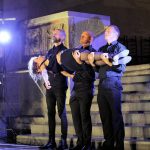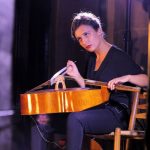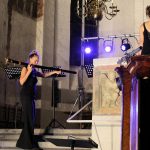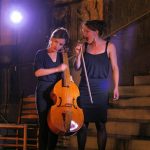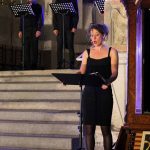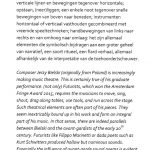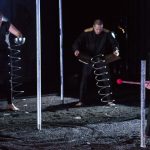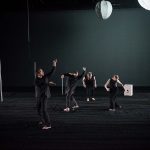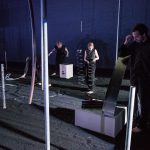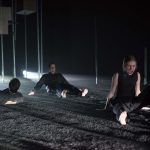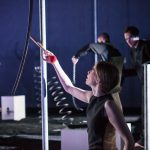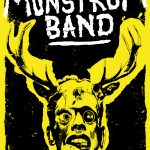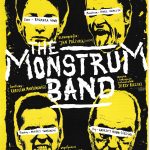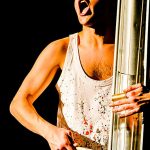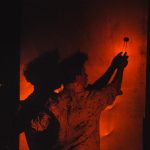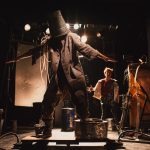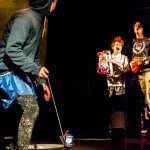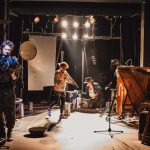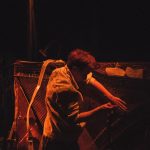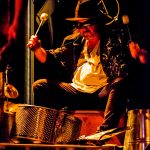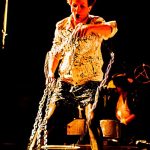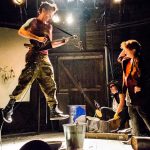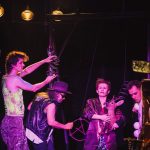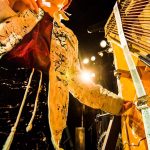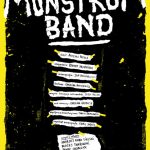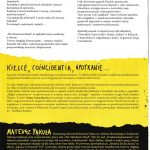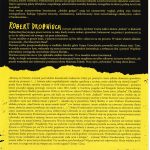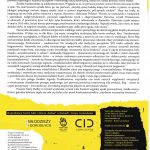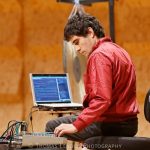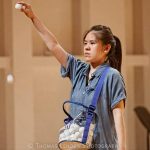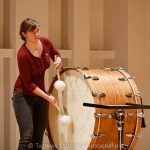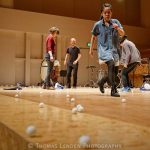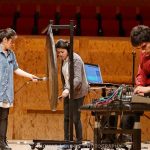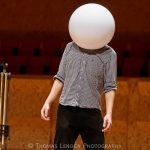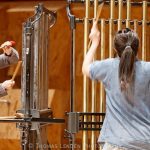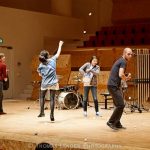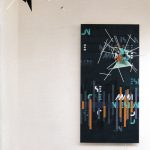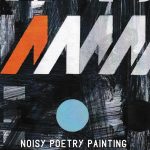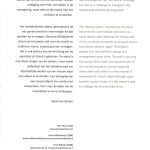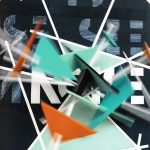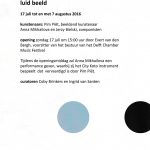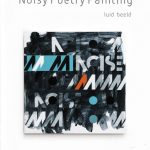-
- TitleZUAM
- DescriptionZUAM is an immersive location based opera-ritual for four opera singers, Deaf dancer, electronics and video. It tells the story of an ancient-futurist tribe living in a world suspended between prehistoric times and distant future. In a 2,5 hour experience it explores the UrSprache, the proto-language researched by the Futurist poets, Antonin Artaud and Peter Brook as well as the sign language.
ZUAM is an attempt to reconnect with our inner self. It’s a meditative experience for the battered soul of a 21st century person, constantly overwhelmed and slightly lost in a fast changing world. It aims to give the audience a metaphysical and cathartic experience, speaking directly to the subconscious, while getting away from the outside reality.
The music is inspired by Bielski’s previous discoveries in the extended non-language-based vocal field, as well as the traditional music of Inuit, Tibetan, Sioux, Zulu, and Balinese people, with the addition of Celtic war instruments, Tibetan and Bhutanese ritual horns – all heavily processed electronically.
Technology plays an important part in the performance. The audience is scattered around an open space, surrounded by a circle of light tubes with two 4 meter high monoliths between them. One made of loudspeakers, the other out of LED screens projecting rhythmical shapes, noise and tribal patterns. A large controlled cloud of smoke appears in the centre of the area with faces of the ancestors projected on it.
- CreditsConcept, composition, stage direction, libretto: Jerzy Bielski
Visuals, video, dramaturgy, lighting: Thomas Brand
Choreography: Sandra Abouav
Electronics, audiovisual programming: Tatiana Rosa
(Deaf) dancer: tba
Soprano, movement: Olga Siemienczuk
Soprano, movement: tba
Bass, movement: tba
Bass, movement: tba
Photos & video: Thomas Brand - Performed atZUAM started as O. Lab at O. Festival for Opera.Muisc.Theatre in Rotterdam in 2022 with the premiere planned for May 2024 at the same festival. It will be performed in unique locations like abandoned factories, industrial buildings, beaches, forests and regular theatres.
- Supported byFonds Podiumkunsten, Oerol, O. Festival for Opera. Music. Theatre, Amsterdamse Bostheater
-
- TitleFish dance when they are not sleeping
- DescriptionOpera for the DEAF
This new opera piece is a true collaboration from the start, between the two cultures or worlds, the ones who use voice and the ones who use gestures in order to communicate or create. The performance takes place between the unreal world of a dream, with blurred, bended forms, eluding reason and logic, and the over exaggerated quasi-reality of the raw rationalist world. This intimate piece is partly an attempt to understand the frustration of Deaf people resulting from their misunderstanding by hearing people, and partly the creation of a space in which both these worlds and types of perception as well as methods of communication interpenetrate and influence each other.
With this concept in mind, we challenge and redefine the format of an opera, making it more inclusive towards the group, which is perhaps the most excluded from it. Therefore, it is our obligation, the people who can hear, to open the doors for the excluded community. That is why Fish dance when they are not sleeping has to look and sound different from any other operatic piece made exclusively for the hearing people.
The piece addresses both the Deaf and hearing audience, and it aims, apart from the artistic value, to draw the attention of most of us to the Deaf communities, with their own, separate culture, language, forms of expression, and, most of all their very different perception of the world. It is a beautiful and very special project, reaching for a truly unique quality.
Libretto and parts of the storyline are being created by Ilse Jobse, who is a Dutch Deaf poet, singer and actress. New technologies, such as motion sensors translating the sign language into audio, computer programmes translating the sound of a spoken voice into abstract visual shapes (as well as written text) which are then translated into dance, sign language translated into musical rhythm as well as sound processed by live electronics – all contribute to an entirely new artistic language and unique aesthetic characterising this piece.
This is a co-production with Dutch National Opera and European Network of Opera Academies (ENOA).
- Press
- CreditsConcept, composition, stage direction, libretto: Jerzy Bielski
Choreography, dramaturgy: Sandra Abouav
Lighting, video, visuals, dramaturgy: Thomas Brand
Libretto: Ilse JobseDeaf singer: Ilse Jobse
Deaf actor: Ali Shafiee
Deaf dancer: Dennis Massar
Deaf dancer: Sharon Wesseling
Deaf dancer: Pawel Moleda
Soprano: Olga Siemienczuk
Paetzold recorder: Juho Myllyla
Cello: Pau Sola Masafrets
Live electronics, audiovisual programming: Tatiana Rosa
Photos: Kim Krijnen, Thomas Brand - Performed atIt is an ongoing project, developing through a series of labs held at the DNO in Amsterdam since 2022 with the premiere planned for 2024.
- Supported byDutch National Opera, European Network of Opera Academies (ENOA)
-
- TitleA.
- Descriptioninterdisciplinary VR experience
This surreal existential tale driven by a musical score tells a story of an anonymous individual, who suddenly finds himself alone in the middle of an ocean. Disappointed by modern, superficial society, he chooses an "inner emigration" to his own safe space out in the open sea. There he is plagued by visions of the world he wanted to leave behind; dreams, half-forgotten memories and visions of the future surround him all around. When A. tries to flee from this confrontation, we become increasingly entangled in his subconsciousness. We are inside the A.’s world almost like inside the belly of a whale. We gradually discover what haunts him and the reason why he withdrew from life and society.
It is an ongoing project, with a premiere planned for 2023.
- CreditsTeam:
Concept, cinematography (360), animation: Thomas Brand
Concept, music, text: Jerzy Bielski
Audio design, Ambisonic audio mix: Tatiana Rosa
Actor ("A."): Aleksej Ovsiannikov - Performed atIt is an ongoing project, with a premiere planned for 2023.
- Supported byFilmfonds / Stimuleringsfonds
-
- © Marta Musial
- © Marta Musial
- © Marta Musial
- © Marta Musial
- © Marta Musial
- © Marta Musial
- © Marta Musial
- © Marta Musial
- © Allard Willemse
- © Allard Willemse
- © Allard Willemse
- © Allard Willemse
- © Allard Willemse
- © Allard Willemse
- TitleNo-One Show
- Descriptionimmersive VR music theatre experience
In the age of Artificial Intelligence, omnipresent, communicating with us internet bots and algorithms leading our search engines and, therefore, heavily influencing our access to information and world’s view, is a performer still an essential part of performance? Or can technology already surpass humans, replacing us in this role? And if so, how autonomous such an “androidic” performer could be from its human creator/programmer? And could it ever set free, or even better, multiply itself into few separate beings, having a simultaneous (artistic) conversation with each other? How could it communicate with us and what kind of communication would that be?No-One Show takes a viewer on a virtual, audiovisual journey through a world dominated by systems of algorithms and codes, to (re)discover the essence of being human. It allows one to immerse in parallel realities and to witness thrilling competition between a human and AI happening in front of our eyes.Composer and interdisciplinary art maker Jerzy Bielski, has been redefining music, theatre, installation and performance art blend in his own way for a few years now with his group Futurists. In 'No-One Show' even the performers disappear from stage. This highly innovative movie/live spectacle, created partly by AI, searches for the definition of humanity in our hi-tech inflicted 21st century.
- PressJerzy is a composer who doesn't think in scores but in total concepts. He is pushing the boundaries of music theater with great ambition.
– Tobias Kokkelmans (O. festival dramaturg)A bit of magic and a bit of ‘return to nature’ style also appeared in Jerzy Bielski’s "No-One Show". VR isn’t merely a trendy addition in here, but a medium, of which full potential has been used allowing to create results impossible to achieve any other way. However, the intense multimedia experience is only an introduction to much more…the ending being a positive surprise for many people.
– Krzysztof Stefanski (“Ruch Muzyczny”, September 2021)CreditsConcept, composition, text, performance: Jerzy Bielski
Audio, sound design, video programming: Tatiana Rosa
Director of photography, light design, film post-production: Thomas Brand
Costume: Karolina Maksimowicz
Photos: Marta Musial, Allard WillemseSupported bySilbersee, Gaudeamus, Stimuleringsfonds Creatieve Industrie, Prins Bernhard Cultuurfonds, NORMA fonds
- TitleNONline Opera
- DescriptionAn ode to a live meeting of an artist and the audience, or live meeting of people in general – as opposed to an online performance or a Zoom meeting. This partly a concert and partly performative “happening” takes form of a collage of events, scenes, music pieces, bits of (made-up) storytelling, videos and absurd comedy sketches – referring to the theater varieté form. NONline Opera is an interactive online/live event based on the music of C i r c u i t, a highly eclectic (experimental rock, hyper jazz, contemporary classical, avant-garde electronics) 8-piece ensemble from London, UK, led by a Polish composer-performer, Jerzy Bielski.
Apart from the enthusiastic Celebration of Live (however, often with surreal, lost in translation misunderstandings, language mishaps, or speaking in codes instead of openly), this piece it is equally about addressing the issues, which are deeply rooted in our every day reality, such as: over-consumerism, greed, AI and technology-inflicted world, polarisation of societies, and social revolution of today. That’s why, in the end it becomes an attempt to make sense of the chaotic reality we happen to be living in, with a huge chunk of humour and distance to it, focusing on an interaction and creating a bond with the audience. Videos and other visual elements (animation, kinetic text, elaborate lighting) play a very important role in the show as well, emphasising the meaning of messages behind Circuit songs and making the whole experience a wholesome
“feast-for-the-senses”. - PressAbout Circuit:
The band sounds like nothing else before them (…) [Circuit] is much more than nine instruments on one stage. It‘s a real riddle for a music lover and can by no means be pigeonholed or bore.
– Goniec Polski (London, UK)Circuit’s music is a patchwork of all possible styles, a blend of music and performance art that combines sound and silence, images, samples and murmurs. It’s a deconstructionist approach to music.
– Port Kultury (Katarzyna Gajewska, Gdańsk)Song ‘Thank you from the mountain’ simply knocks you off your feet.
– Cooltura (Piotr Dobroniak, London) - CreditsCreative team:
concept, composition, text: Jerzy Bielski
dramaturgy, videos, video post-production, lighting: Thomas Brand (NL)
acting advice: Martijn Nieuwerf (NL)Performers:
actor (“The Composer”): Martijn Nieuwerf (NL)
flute, samples: Tatiana Rosa (NL/POR)
voice: Olga Siemienczuk (DE/PL)
guitar, voice: Jerzy Bielski (NL/PL)
trumpet: Matt Ellis Devitt (UK)
drums: Zach McCullough (USA/GR)
double bass, bass guitar: Ed Babar (UK)
piano, keys: Abel Tuinstra (NL) - Performed atGaudeamus
- Supported byFonds21, Prins Bernhard Cultuurfonds, BNG Fonds, Gaudeamus
- Zamenhof project. Huis Utrecht. Asko Schoenberg. Gaudeamus. Photo: Allard Willemse
- September 2019. Het Huis Utrecht. Doorloop Zamenhof project. Akso Schoenberg Ensemble. Gaudeamus Festival 2019. Photo: Allard Willemse
- Zamenhof project. Huis Utrecht. Asko Schoenberg. Gaudeamus. Photo: Allard Willemse
- Zamenhof project. Huis Utrecht. Asko Schoenberg. Gaudeamus. Photo: Allard Willemse
- September 2019. Het Huis Utrecht. Doorloop Zamenhof project. Akso Schoenberg Ensemble. Gaudeamus Festival 2019. Photo: Allard Willemse
- September 2019. Het Huis Utrecht. Doorloop Zamenhof project. Akso Schoenberg Ensemble. Gaudeamus Festival 2019. Photo: Allard Willemse
- September 2019. Het Huis Utrecht. Doorloop Zamenhof project. Akso Schoenberg Ensemble. Gaudeamus Festival 2019. Photo: Allard Willemse
- September 2019. Het Huis Utrecht. Doorloop Zamenhof project. Akso Schoenberg Ensemble. Gaudeamus Festival 2019. Photo: Allard Willemse
- September 2019. Het Huis Utrecht. Doorloop Zamenhof project. Akso Schoenberg Ensemble. Gaudeamus Festival 2019. Photo: Allard Willemse
- September 2019. Het Huis Utrecht. Doorloop Zamenhof project. Akso Schoenberg Ensemble. Gaudeamus Festival 2019. Photo: Allard Willemse
- September 2019. Het Huis Utrecht. Doorloop Zamenhof project. Akso Schoenberg Ensemble. Gaudeamus Festival 2019. Photo: Allard Willemse
- September 2019. Het Huis Utrecht. Doorloop Zamenhof project. Akso Schoenberg Ensemble. Gaudeamus Festival 2019. Photo: Allard Willemse
- September 2019. Het Huis Utrecht. Doorloop Zamenhof project. Akso Schoenberg Ensemble. Gaudeamus Festival 2019. Photo: Allard Willemse
- Zamenhof project. Huis Utrecht. Asko Schoenberg. Gaudeamus. Photo: Allard Willemse
- September 2019. Het Huis Utrecht. Doorloop Zamenhof project. Akso Schoenberg Ensemble. Gaudeamus Festival 2019. Photo: Allard Willemse
- TitleZamenhof Project: Breaking the Codes
- DescriptionIt's a project inspired by the ideas and the life of a linguistic genius Ludwik Zamenhof. In this large-scale interdisciplinary piece Bielski constructs a world which surprises, challenges and confuses. His work, praised by the public and the press, is unconventional, limitless and deliberately outside any boxes. The international cast, consisting of actors, musicians and dancers who between them speak seven languages, involves the audience in an exploration of communication (or miscommunication) and language. An event in which music and visual elements such as theater, contemporary dance, installation, video, set design, costumes and light are completely integrated. The traditional separation of stage and audience also becomes blurred.
(from Muziekgebouw aan 't IJ website) - Press
With Zamenhof Project: Breaking the Codes, Polish music theater maker Jerzy Bielski, artist-in-residence at Gaudeamus, brought an ode to Ludwik Zamenhof, creator of Esperanto and a champion of world peace. With Bielski no precise sound explorations, but a Babylonian collage of texts and languages, noise, pop, jazz, punk, sketches, DNA and computer codes, Zappa-like madness and public participation (...)
Bielski (who played the guitar himself) and his performers hoisted in tracksuits put down a highly energetic and well-timed show, in which there was also room for stillness. (...) Bielski has an undeniable sense of theater. Zamenhof Project was musical "monkey cages" for advanced, at high speed and full of dedication.
– NRC **** (Joep Stapel, 6 September 2019)
- CreditsConcept, Composition, Text, Installations/Scenography Design, Artistic & Production Leader: Jerzy Bielski
(Final) Stage Direction: Frances Sanders
Stage Movement: Sandra Abouav
(Initial) Stage Direction: Laura Jakschas
Set Design, Costumes, Installations: Karolina Maksimowicz
Light Design: Thomas Brand
Video, Installations: Felix de Bousies
Audio, Video, Live Electronics: Tatiana RosaVoice & Movement:
Richard Dubelski (France)
Eva Layla Schipper (Netherlands)
Felix de Bousies (Belgium/Greece)
Akim Moiseenkov (Netherlands)
Pawel Chomczyk (Poland)
Claire Malchrowicz (France)
Kirstine Lindemann (Denmark)Piano, MIDI-keyboard (Asko|Schönberg – K[h]AOS): Tim Sabel
Percussion, Drums (Asko|Schönberg – K[h]AOS): Noè Rodrigo Gisbert
Guitars: Jerzy BielskiProduction Assistant: Matthijs Mantel
Zamenhof Project: Breaking the Codes is a coproduction of Foundation Futurists and Gaudeamus.
- Performed atMuziekgebouw aan 't IJ (Amsterdam), Het Huis Utrecht, Kelmis (Belgium)
- Supported byMain Partner: Gaudeamus
Other Partners:
Asko|Schönberg, Fonds Podiumkunsten, Amsterdams Fonds voor de Kunst, Adam Mickiewicz Institute, Warsaw Autumn, Compagnie METAtarses, Muziekhuis Utrecht, Het Huis Utrecht, Instytut Teatralny im. Z. Raszewskiego, Amsterdamse Bostheater, Intro In Situ, Meakusma, Universal World Esperanto Association, Esperanto Nederland (Rotterdam), Grupa Coincidentia, Białystok Esperanto Assotiation, Przetwórnia Meblowa Białystok
- © Anna van Kooij
- © Anna van Kooij
- © Thomas Lenden
- 1 © Anna van Kooij
- © Thomas Lenden
- © Polle B. Willemsen
- © Thomas Lenden
- © Thomas Lenden
- © Co Broerse
- © Anna van Kooij
- © Thomas Lenden
- © Thomas Lenden
- © Polle B. Willemsen
- © Polle B. Willemsen
- © Co Broerse
- © Thomas Lenden
- Leaflet – Back
- Best of Fringe tour leaflet
- Titlenot only FUTURISTS
- DescriptionMusic theatre project with the aim of staging the poetry, manifestos and the other writings of the Italian, Russian and Polish Futurists from the early 20th century (as well as the anti-Futurist writer, S.I. Witkiewicz, from the same period). Recreating the revolutionary spirit of their original performances was, however, only a starting point or a pretext to have a much closer look at our contemporary society through the 'prism' of the Futurists' often radical ideology and aesthetics.
- PressThis exceptional concert conceived by Jerzy Bielski combines (non) music and theatrical performance to provide an hour-long (art) history lesson laced with humour (...)
[Futurists is] a group of fearless thinkers who expose our common madness, our willingness to rush headlong into the fray without heeding the outcome. (…)
They are not cute, they don't even try to be nice. They are loud, they are brash, they take no prisoners. They brought a goldfish and they're on a mission to show us that we have a problem, and it's only going to get worse.
– The Critter (South Africa, Steve Kretzmann, Sep 13 2015)Awards:
Gold Award at Amsterdam Fringe Festival 2015 (Dioraphte Award) - CreditsConcept, text, compositon: Jerzy Bielski
(Final) Stage direction: Laura Jakschas (DE)
Technical Consult./Machines: Felix Bousies (BE/GR), Tatiana Rosa (NL)Voice & movement:
Marko Ivic (HR)
Pia Podgornik (SL)
Olga Siemienczuk (DE)
Matthias Sigurdsson (IC)
Kirstine Lindemann (DK)
Jerzy Bielski
Prepared Piano/Live Electronics: Panos Iliopoulos (GR)
Live Electronics: Akim Moiseenkov (NL)
Drums/Found objects: Tristan Renfrow (USA), Olaf Rykała (PL) - Performed atGaudeamus Muziekweek, Amsterdam Fringe Festival, National Arts Festival (South Africa), Café OTO (London), Theater Bellevue, Theater Kikker, RASA, Mazowiecki Instytut Kultury (Warsaw), MOCAK (Kraków)
- Supported byAmsterdams Fonds voor de Kunst, Amsterdamse Hogeschool voor de Kunsten, Fonds Podiumkunsten
- © Saris & den Engelsman
- © Saris & den Engelsman
- © Saris & den Engelsman
- © Saris & den Engelsman
- © Saris & den Engelsman
- © Saris & den Engelsman
- © Saris & den Engelsman
- Leaflet
- TitleMORE (White-Red-Black)
- DescriptionAnti-war piece exposing the underlying aims of large corporation CEOs, bankers and politicians, which make them start and run bloody conflicts around the world. This collage of images, frightening and beautiful at the same time, soundscapes and precise choreographies, often contrasts with melancholic parts in the piece, which emphasise the peaceful, paradise-like setting of the Bostheater and our distance to the violence going on every day around us. At one point the performers break it and take the action off stage, bringing it close to the audience, so that it becomes a whole new experience in the end.
The stage of the Amsterdam Bostheater serves as a sea, whether it is filled with oil or with refugees. The isolated images in this performance look surreal against the paradise background of the Bostheater. Two worlds come together, revealing our distance or negligence to the 'other world', which exists every day.
Interdisciplinary piece for 7 performers (actors, dancers, musicians), putting the powerful people of the world (multinational corporation directors, politicians, bankers, etc.), next to the ones affected the most by their decisions (homeless people, soldiers taking part in wars, their civilian victims and refugees), confronted with the 'average public members'. The effects which come out of this are from highly poetic and lyrical up to absurd and hyper realistic, connected to our every day world, however intertwined with abstract musical and visual images and soundscapes.
The piece is rich in unusual sound layers and strong visual elements. Dramatised and choreographed scenes are accompanied by spoken voice arrangements, live percussion, electronics, guitar and a prerecorded soundtrack.
- PressMusically iron strong (…)
– Het Parool (Amsterdam, Sander Janssens, July 2016)Jerzy Bielski lets a few musicians, technical assistant, and a few mimers to, quite literally, take possession of this enormous space, of this science fiction graveyard. With their performance, they tell a story-not-a-story, about self-fulfilling egos, which are just a little too comfortable delusions, and therefore are overwhelmed by a stroboscopically highlighted war on terror. As the three performers hang half-dead on the ropes or are being buried alive by the assistant, the searchlights high above us say to us that it’s our turn now, the spectators at the tribune. I won’t give away what happens next.
– De Groene Amsterdammer (Amsterdam, Loek Zonneveld, July 2016) - CreditsConcept, text, music, choreography, scenography, costumes, light design: Jerzy Bielski
Scenography Assistant: Maciej Nosal
Actors: Eline van Gils, Joey Schrouwen, Mees Borgman, Maciej Nosal
Prepared Piano/Live Electronics: Panos Iliopoulos
Drums/Percussion: Tristan Renfrow
Guitars: Jerzy Bielski - Performed atAmsterdamse Bostheater
- Supported byAmsterdamse Bostheater
- © Joseph Steele
- © Joseph Steele & Jerzy Bielski
- © Arkadiusz Sikorski
- © Jerzy Bielski & Joseph Steele
- © SPATiF
- © Ula Wiznerowicz
- © Joseph Steele
- © SPATiF
- © Jerzy Bielski & Joseph Steele
- © Ula Wiznerowicz
- © Ula Wiznerowicz
- © SPATiF
- © SPATiF
- © Arkadiusz Siokrski
- TitleCircuit
- DescriptionThough a prosaic name like Circuit may not jump at you on a festival poster, this bunch’s modus operandi epitomises all kinds of absurd. Circuit isn’t so much a band as it’s a lab of musical Mad Scientists. This winsome collective channels the satirical sloganeering of Devo, the frantic genre-hopping of Mr. Bungle and the slapstick theatrics of Zappa and his Mothers. If these names ring true to you, however, you’ll know there’s nothing remotely comparable to Circuit’s all-out musical smorgasbord and quirky shenanigans.
(from “Le Guess Who?” page)Highly experimental rock, jazz, free-spirited 8-piece avant-garde, energetic, eclectic & electric ˙&*^!&•¶_%’ band Circuit, with lots of live electronics, harp, cello, classical “contemporary” sounds, strong rhythm and horn section, improv all around, etc. etc.. etc…The band has been formed in 2009 in London, UK, out of people coming from different backgrounds, countries and environments: jazz, sonic arts, classical, Middlesex University, Europe, Asia and America(s). They’ve been touring internationally and recording extensively ever since.
- PressA rollicking, ingenious, painstakingly orchestrated record that draws from nearly every available genre of music, Circuit’s “Codes” is an achievement bespeaking musical creative greatness and genuine artistic integrity in its each and every attribute. (...) Like a novel by James Joyce, the album is chock full with signs and symbols.
– MondoTunes (USA, Sean McCauley, November 2012)One of the main strengths of the band is its front man Jerzy Bielski (...) Circuit’s music is a patchwork of all possible styles, a blend of music and performance art that combines sound and silence, images, samples and murmurs. It’s a deconstructionist approach to music; the band misleads its audience with sudden changes of rhythm, style and instrumentation.
– Port Kultury (Gdańsk, Katarzyna Gajewska, October 26, 2012)A song called ‘Thank you from the mountain’ simply knocks you off your feet
– Cooltura (London, Piotr Dobroniak, June 19, 2011)The concert was excellent. It testifies to the fact that young people are, unselfconsciously, making sounds and harmonies that are beyond the comprehension of those who just sit in front of their TV.
– SPATiF (Sopot, Arkadiusz Hronowski, 25 October 2012)Jerzy also writes music for theatre and shows up in various music projects, which provides evidence of his indefatigable artistic resources and hunger for creativity. (...) With mathematical precision, he has been drawing up notes, polishing lyrics and gathering the best musicians to complete his ambitious project [Circuit].
– Kobieta w UK (London, Małgorzata Przymierska, 3 March 2010)The band sounds like nothing else before them, even if some compare the group to the likes of Frank Zappa, Pink Floyd, Loose Tubes or classical composer Gyorgy Ligeti – there are moments when these wide-ranging influences are apparent, but it is safe to say that the style of Circuit is eclectic
and can only be described as a mixture of many styles with an emphasis on rock and with an experimental approach to form, where tight rhythms and fast tempos contrast with open out-of- time free solos.[Circuit] is much more than nine instruments on one stage. It‘s a real riddle for a music lover and can by no means can be pigeonholed or bore.
– Goniec Polski (The Polish Times, London, issue 372, 22 April 2011)Awards: Emerging Excellence Award (Musicians Benevolent Fund, UK)
- CreditsMusic & lyrics: Jerzy Bielski
Voice & guitar: Jerzy Bielski
Trumpet: Matt Ellis
Bass: Ed Babar, Theo Ziarkas, Geoff Threadgold
Harp: Cristina Di Bernardi
Cello: Evva Mizerska, Sarah Joyce
Live Electronics: Felix de Bousies, Kacper Ziemianin
Drums: Zach McCullough, Daniel Jekey
Tenor Saxophone: Seb Silas, Claire Ellis, Dan Mays, Rob Cope
Piano: Maria Chiara Argiro, Ewan Duffus, Espen Tjalve,
Rob Barron
Trombone: David Lalljee - Performed atvarious different venues in the UK, Belgium, Netherlands and Poland
- Supported byMusicians Benevolent Fund (UK)
- Title+ - / , 1 = _ ; X %
- DescriptionSat at a ‘board meeting’, four performers explore the every-day influence of the world of banks and large corporations on our life. With rhythm, voices, carefully studied gestures and face expressions, they expose the underlying messages and hidden goals of that specific world, twisting and distorting them on the way. The audience is an active participant, following the leaders’ obsessive drive for competition and the will to control people’s desires and dreams. Fast-paced, dynamic action literally draws an audience into it, making it all round immersive experience.
- PressThe success of this performance lies not only in the fact that with modest means (chairs, tables, paper, and a beamer) a whole new universe is convincingly evoked in front of the audience’s eyes, so that they cannot do anything else but join in…Also, the success lies, just as much, in the detailed choreography, which, while at the same time helping the performers on stage/the meeting room, it nearly aggressively puts a full control over the piece’s atmosphere into their hands.
– Theaterkrant **** (Netherlands, Pieter Rings, September, 2016)This is a performance that you do not forget (...) The way Bielski and Abouav make theater is anything but traditional.
– Het Parool **** (Amsterdam, Camila Bennink, September, 2016)The true impact of + _ /, = _ X% by composer Jerzy Bielski, comes with the delirious criticism of the irrational chaos of financial markets, using the means of systematic choreography. That’s why, we are delighted to say, that the project will continue and you will be able to revisit it soon.
– Ballroom Review of Dance (Paris, Marie Juliette Verga, December, 2015)(…) in this funny and participative piece the composer closely looks at expectations, behaviors and troubles. The point of the game is to be as close to the audience as possible. In his recent works, the artist has been seeking to integrate the audience in a more and more participative way. It’s a new opportunity to experience/experiment with other forms of relationships between sound environment and viewers’ reception.
– Royaumont Festival (Paris, Irène Filiberti, August 2015)Awards:
Finalist of the Dance Élargie International Competition (Seoul, South Korea, 2016) - CreditsConcept, music, text, scenography: Jerzy Bielski
Dance collaboration: Sandra Abouav (FR)
Music collaboration: Stopcontact (NL)
Performers: Sabine Rivière, Panos Iliopoulos, S. Abouav, J. Bielski - Performed atSPRING Festival (Utrecht), Festival de Royaumont (France), Amsterdam Fringe Festival, Gaudeamus Muziekweek, Gaudeamus Sessions (Utrecht) Danse Èlargie festival (Seoul)
- Supported byGaudeamus Foundation, Royaumont Foundation, Fonds Podiumkunsten
- TitleYes No!
- DescriptionManipulation by mainstream media, large corporations and politicians and its influence on our daily lives. The subject of this piece is tackled by the use of misleading information, contradictory messages (experimenting with sound and optical illusion) and turning the audience's attention to their own senses, with the aim of making them sharper and more attentive in the end. The full scale, an hour long interdisciplinary piece for video, MIDI programmed organ(s) and stage performance will comprise of dramatised scenes, video and live electronics.
Highly engaging and entertaining, requiring a lot of precision and involvement from all the performers, with the active audience participation - the piece will also aim at exposing the hidden ways used by news programs as well as advertising and political campaigns (diverting the general public/audiences’ attention away from the real problems, focusing it on something else, or even ‘manufacturing’ the information for their own purposes). This will be achieved by exploring the sound and optical illusion in a creative way, using sound sources not visible to the audience, Busy Drone and the Sauer organ playing ‘by themselves’, performing silently, having blurred boundaries between what’s ‘real’ and what’s ‘not real’, what’s live and what’s being played back from ‘tape’ (or pre-programmed on a computer), who or what is making the sound in the given moment or where it’s coming from, etc...
- CreditsConcept, music, text, movement, video: Jerzy Bielski
Organ: Jacob Lekkerkerker
Organ/Live Electronics: Panos Iliopoulos
Voice/movement: Erwin Dörr, Marieke Dermul
Video: Igor C. Silva
Video/Lights: Felix de Bousies - Performed atOrgelpark (Amsterdam)
- Supported byOrgelpark
- Title#tristanisolde – |__< \ 3 (tR/sLd.Nr_tK'm)
- DescriptionBased on the myth of Tristan and Isolde itself and not so much on its adaptation by Wagner or Lang. Using different colours of male and female voices, experimenting with them, however, always keeping in mind the main subject of the piece, which is love, with all the obstacles and the tragic context of the original story.
Exploring the possibilities of voice (sung and spoken, using different sounds modulated in mouth, syllables and extended techniques) plays a big role in the performance. Percussion and live electronics (live processing, live sampling, pre-recorded voices and other sounds) accompany that, creating a background, counterpoint, as well as relating in different ways to the main action.
- CreditsConcept, direction, music, scenography, costumes: Jerzy Bielski
Voice/movement: Ine Claes, Vincent van Woerkom, Jerzy Bielski
Percussion: Tristan Renfrow
Live Electronics: Igor C. Silva - Performed atMuziekgebouw aan ’t Ij (Amsterdam)
- Supported bySilbersee
- TitleDown/Up
- Description"(…) the influence of avant-garde sound poems is evident in the two pieces Up and Down. The soprano rolls r’s, slides over a variety of sounds lie ‘aa’, ‘oo’, and ‘e’. Singers rasp g’s, grumble ‘w, rr, z, ź, g, b, c, k, dż, pff, czsz’ and breathe out their last breath. Bielski searches for a different language in the singing voice, one that is not based on the understandability of words.
But Bielski’s work also refers to innovator Antonin Artaud who aimed at removing textual and psychological drama from theatre and replacing it with new aspects, such as movement, colour, light, sound, music–what can be felt but not really expressed. Bielski’s symbolism is based on similar thinking. Everything is a foil for something else as he pairs vertical and horizontal lines and movements, standing up and lying down, a single note and rapid downward runs, horizontal and vertical handling of instruments. He also enforces unusual playing techniques as hands move from left to right, up or down. All these elements add hidden meaning to the overall narrative until it becomes a ritual or the snippet of a story, depending on the interpretation of the listener/viewer."
– Jan Nieuwenhuis (Program Notes) - Press(...) strong was the diptych "Up" and "Down" by Jerzy Bielski: a dramatic oratorio cut loose from language and meaning. Both parts condition clever mirror effects, but rapture was mainly because of the exciting interaction between the soprano and the instrumentalists.
– NRC (Joep Stapel, 12 September 2016)A nice contrast (...) with the crazy, energetic pieces "Up" and "Down" by the Polish composer Jerzy Bielski (1984). His approach is distinctly theatrical.
– Culuurpers (Utrecht, Thea Derks, September 10, 2016) - CreditsMusic, movement: Jerzy Bielski
Conductor: Manoj Kamps
Soprano: Sterre Konijn
Male voices: Arnout Lems, Maciej Straburzyński, Steven van Gils
Fujara: Raphaela Danksagmüller - Performed atGaudeamus Muziekweek
- Supported bySilbersee, Gaudeamus Muziekweek
- © Robert van der Ree
- © Robert van der Ree
- © Robert van der Ree
- © Robert van der Ree
- © Robert van der Ree
- TitleCelebration of Life
- Description.
- CreditsStage direction: Espen Hjort
Installations/instruments design, performers’ coaching: Jerzy Bielski
Scenography: Ruben Wijnstock
Costumes: Brenda van Geffen
Dramaturgy: Jessica Kuitenbrouwer
Performers: Mees Borgman, Lotte Driessen, Steven Joles, Ervin Dörr
- Poster
- Program notes 1
- © Michal Strokowski
- © Bartek Warzecha
- © Bartek Warzecha
- © Michal Strokowski
- © Bartek Warzecha
- © Bartek Warzecha
- © Michal Strokowski
- © Michal Strokowski
- © Michal Strokowski
- © Bartek Warzecha
- © Michal Strokowski
- Program notes 4
- Program notes 3
- Program notes 2
- TitleThe Monstrum Band
- DescriptionDark story of Frankenstein invented by Mary Shelley, an English writer of the romantic period, became an inspiration for Mateusz Pakuła to write a brand new play. It is a strange catalog of characters, who share a common denominator – they all have been created by human being. Beside Frankenstein’s Monster an author recalls Pinocchio and genetically programmed Eve, and throws them into a surreal meeting. Their therapeutic – music - session develops into a manifesto of ideas and views on the contemporary conditions of humanity, the limits of interference in the nature, value of social relations and political systems. The creators of the show refer to the traditions of the drama of the twentieth century, but also use elements of puppet theater, musical experimentation and mixing of the conventions, inviting viewers to the world of original forms and undiscovered sounds.
- Press(...) the authors managed to create something in between a theatre performance and a concert, in which not only a spooky atmosphere, humor (...) but also some ghastly music has its place. And what music that is! Wildly played on everything, which could be brought to a theater (buckets, chains, pipes, bowls, tin boxes, car’s guts, etc. etc.). The effect is great – this anarchist cacophony not only can be listened to but one indeed wants to do it. This, considering the set of bizarre contraptions, really sounds good. From the sort of a punk mantra, in which the peculiar company sings out, quite nicely, a protest song against a bad judgment of matter's lifelessness, all the way to a perverse bossanova about an almost broken tooth (music and instruments’ design – Jerzy Bielski).
(...) music put together using bizarre instrumentations keeps up to the level.
It's a real musical anarchy. Tugging chains in a tin bowl is so suggestive that you would like to try to tug yourself. The impression is even greater when this is done by a peculiar gallery of corpses from the club of Frankenstein. However, "The Monstrum Band" is by no means just an ominous rock-punk concert and the conventions’ game. It's definitely more than that.
– Gazeta Wyborcza (Monika Żmijewska, November 27, 2016) - CreditsStage direction: Robert Drobniuch
Music, sound installations/instruments design, performers' coaching: Jerzy Bielski
Text: Mateusz Pakuła
Scenography: Jan Polivka
Costumes: Karolina Maksimowicz
Stage Movement: Karolina Garbacik
Dramaturgical collaboration: Tomasz Damulewicz
Scenography Assistant: Kamil Dziedzic
Performers: Dagmara Sowa, Paweł Chomczyk, Błażej Twarowski, Andrzej Kuba Sielski - Performed atWestfluügel (Leipzig), Teatr Lalki i Aktora “Kubuś”, Białostocki Teatr Lalek, Solniki 44 (Poland), Festiwal Konteksty (Poznań), Festiwal Maskarada (Rzeszów)
- Supported byTeatr Lalki i Aktora (Kielce, Poland), Grupa Coincidentia
- © Thomas Lenden
- © Thomas Lenden
- © Thomas Lenden
- © Thomas Lenden
- © Thomas Lenden
- © Thomas Lenden
- © Thomas Lenden
- © Thomas Lenden
- TitleRed Square, Black Circle, Blue Triangle
- DescriptionImagining "every day" rhythms and their very different percussive sources forming into various micro and macro patterns – as an input for possible endless mutations and transformations.
Also, taking a deep plunge into their textural and timbral exploration using live coding and quadraphonic speaker set up.
- CreditsComposition: Jerzy Bielski
Percussion: Yung-Tuan Ku, Sujin Hwang, Lola Mlacnik, Mauricio Ramirez
Live Electronics: Felipe Ignacio Noriega - Performed atComposers Festival
- TitleThe Disappearance of Mrs. Price
- DescriptionA mime-musictheatre-trhiller
Imagine: you're wandering around a somewhat wasted, old school terrain. A child signals you to approach. It brings your ear to a pipe and you hear strange voice sounds of a singing class. Through a peephole in a curtain you see an adult group in school uniforms. While you watch them doing a strange ritual, the child whispers in your ear:
Twenty years ago this class had a teacher.
Mrs. Price
One day she disappeared and never came back
The class stayed. They can't go, they are trapped.
Some think mrs Price has gone to a better world and they think they will go there too if they do exactly as she did.
But I think mrs Price disappeared
I think one of them that killed her
Come, there is a secret entrance, I can get you inside...The moment you've entered the door, the children lock it behind you and run away laughing. You sit down on a schoolbench and find yourself in an oppressing atmosphere, kind of like a dream. The class does a daily school routine that doesn't stop. There seems to be a system that is very organised: everyone has its' fixed place, task and function in the group.But slowly small cracks appear in the machinerie. There are group members that dream of change. That secretly, when no one is watching, dance. That observe the windows closely in order to find a way out. That touch the things mrs Price left behind and dress themselves as her. But the group is very strict and force everyone back into the system. Even after a big shock or change all group members bounce back like puppets on a spiral spring. Nothing is said out loud, everything is concealed. But what happens when the tension becomes unbearable? If the lobsters find out they are slowly being cooked to death?
- CreditsConcept & stage direction: Sjoeke-Marije Wallendal
Music, sounds concept, instruments: Jerzy Bielski
Scenography & costumes: Sjoeke-Marije Wallendal
Performers: Jerzy Bielski, Panos Iliopoulos, Eva Kijlstra, Anna van Diepen, Mervyn Groot, Aline Combe - Performed atSPRUIT Festival
- Supported byKameroperahuis
- © Jerzy Bielski
- Exhibition booklet 1
- Exhibition booklet 2
- Exhibition booklet 3
- Exhibition booklet 4
- Exhibition booklet 5
- TitleTurning Point
- DescriptionThe work Turning Point from 2015 is the first collaboration of painter Pim Piët with the Polish composer Jerzy Bielski (1984). One speaker had to be mounted outside the panel, and this was a new challenge for Piët, not only in its design but also as a challenge to strengthen the relationship with the painting itself. The rotating object, mounted in the panel becomes the intermediate and seems to catch signals, again blurring the sliding scale of the visual plane towards aural space where boundaries become vague. That idea is exactly how the exhibition design and arrangement came to be. The wall is not only the carrier of the work, but it becomes a part of the overall concept to connect separate works with each other in a new manner. A movement of a visual object through space towards sound/noise. It is the viewer’s task to undergo the musical experience.
– Ingrid van Santen (from the exhibition booklet) - CreditsPainting: Pim Piët
Music: Jerzy Bielski - Performed atGalerie Sophie (The Hague), Kadmium (Delft), pARTners Gallery (Rotterdam), De Haagse Kunstkring (The Hague)
- TitleBibi Ha Bibi
- DescriptionWearing skin-tight playsuits, Aloun Marchal and Henrique Furtado weigh each other up, stare at each other, stand firm in the middle of the stage and let out a cry from deep inside : the challenge is laid down. Face to face, close to each other, conniving and provoking at the same time, they are getting ready. They explore a wide range of sounds and movements with clashing styles, from sports fighting to teasing childish games, from rumbling noises to lullabies, from straightforward breathing to bestial yelling. Progressive mechanisms drive the performers even further into their exercise, moving disjointedly and opening their throats more and more. The pas de deux glides from controlled violence to sensuality, which are both disturbingly based on listening, mimicry and exchange of movements. Progressively, voices and faces, laughing and cruel, get tangled, mixed up and rival each other. Henrique
Furtado and Aloun Marchal are ready, at last… - CreditsConcept, creation: Aloun Marchal, Henrique Furtado
Music collaboration: Jerzy Bielski
Dramaturgy: Céline Cartillier
Scenography, costumes: Camille Rosa, Rozenn Lamand
Performers: Aloun Marchal, Henrique Furtado - Performed atvarious venues in: Paris, Göthenburg (Sweden), Lisbon (Portugal), Marseille, Toulouse (France), etc.
-
- TitleZUAM
- DescriptionZUAM is an immersive location based opera-ritual for four opera singers, Deaf dancer, electronics and video. It tells the story of an ancient-futurist tribe living in a world suspended between prehistoric times and distant future. In a 2,5 hour experience it explores the UrSprache, the proto-language researched by the Futurist poets, Antonin Artaud and Peter Brook as well as the sign language.
ZUAM is an attempt to reconnect with our inner self. It’s a meditative experience for the battered soul of a 21st century person, constantly overwhelmed and slightly lost in a fast changing world. It aims to give the audience a metaphysical and cathartic experience, speaking directly to the subconscious, while getting away from the outside reality.
The music is inspired by Bielski’s previous discoveries in the extended non-language-based vocal field, as well as the traditional music of Inuit, Tibetan, Sioux, Zulu, and Balinese people, with the addition of Celtic war instruments, Tibetan and Bhutanese ritual horns – all heavily processed electronically.
Technology plays an important part in the performance. The audience is scattered around an open space, surrounded by a circle of light tubes with two 4 meter high monoliths between them. One made of loudspeakers, the other out of LED screens projecting rhythmical shapes, noise and tribal patterns. A large controlled cloud of smoke appears in the centre of the area with faces of the ancestors projected on it.
-
CreditsConcept, composition, stage direction, libretto: Jerzy Bielski
Visuals, video, dramaturgy, lighting: Thomas Brand
Choreography: Sandra Abouav
Electronics, audiovisual programming: Tatiana Rosa
(Deaf) dancer: tba
Soprano, movement: Olga Siemienczuk
Soprano, movement: tba
Bass, movement: tba
Bass, movement: tba
Photos & video: Thomas Brand -
Performed atZUAM started as O. Lab at O. Festival for Opera.Muisc.Theatre in Rotterdam in 2022 with the premiere planned for May 2024 at the same festival. It will be performed in unique locations like abandoned factories, industrial buildings, beaches, forests and regular theatres.
-
Supported byFonds Podiumkunsten, Oerol, O. Festival for Opera. Music. Theatre, Amsterdamse Bostheater
Read more -
- TitleFish dance when they are not sleeping
- DescriptionOpera for the DEAF
This new opera piece is a true collaboration from the start, between the two cultures or worlds, the ones who use voice and the ones who use gestures in order to communicate or create. The performance takes place between the unreal world of a dream, with blurred, bended forms, eluding reason and logic, and the over exaggerated quasi-reality of the raw rationalist world. This intimate piece is partly an attempt to understand the frustration of Deaf people resulting from their misunderstanding by hearing people, and partly the creation of a space in which both these worlds and types of perception as well as methods of communication interpenetrate and influence each other.
With this concept in mind, we challenge and redefine the format of an opera, making it more inclusive towards the group, which is perhaps the most excluded from it. Therefore, it is our obligation, the people who can hear, to open the doors for the excluded community. That is why Fish dance when they are not sleeping has to look and sound different from any other operatic piece made exclusively for the hearing people.
The piece addresses both the Deaf and hearing audience, and it aims, apart from the artistic value, to draw the attention of most of us to the Deaf communities, with their own, separate culture, language, forms of expression, and, most of all their very different perception of the world. It is a beautiful and very special project, reaching for a truly unique quality.
Libretto and parts of the storyline are being created by Ilse Jobse, who is a Dutch Deaf poet, singer and actress. New technologies, such as motion sensors translating the sign language into audio, computer programmes translating the sound of a spoken voice into abstract visual shapes (as well as written text) which are then translated into dance, sign language translated into musical rhythm as well as sound processed by live electronics – all contribute to an entirely new artistic language and unique aesthetic characterising this piece.
This is a co-production with Dutch National Opera and European Network of Opera Academies (ENOA).
-
Press
-
CreditsConcept, composition, stage direction, libretto: Jerzy Bielski
Choreography, dramaturgy: Sandra Abouav
Lighting, video, visuals, dramaturgy: Thomas Brand
Libretto: Ilse JobseDeaf singer: Ilse Jobse
Deaf actor: Ali Shafiee
Deaf dancer: Dennis Massar
Deaf dancer: Sharon Wesseling
Deaf dancer: Pawel Moleda
Soprano: Olga Siemienczuk
Paetzold recorder: Juho Myllyla
Cello: Pau Sola Masafrets
Live electronics, audiovisual programming: Tatiana Rosa
Photos: Kim Krijnen, Thomas Brand -
Performed atIt is an ongoing project, developing through a series of labs held at the DNO in Amsterdam since 2022 with the premiere planned for 2024.
-
Supported byDutch National Opera, European Network of Opera Academies (ENOA)
Read more -
- TitleA.
- Descriptioninterdisciplinary VR experience
This surreal existential tale driven by a musical score tells a story of an anonymous individual, who suddenly finds himself alone in the middle of an ocean. Disappointed by modern, superficial society, he chooses an "inner emigration" to his own safe space out in the open sea. There he is plagued by visions of the world he wanted to leave behind; dreams, half-forgotten memories and visions of the future surround him all around. When A. tries to flee from this confrontation, we become increasingly entangled in his subconsciousness. We are inside the A.’s world almost like inside the belly of a whale. We gradually discover what haunts him and the reason why he withdrew from life and society.
It is an ongoing project, with a premiere planned for 2023.
-
CreditsTeam:
Concept, cinematography (360), animation: Thomas Brand
Concept, music, text: Jerzy Bielski
Audio design, Ambisonic audio mix: Tatiana Rosa
Actor (“A.”): Aleksej Ovsiannikov -
Performed atIt is an ongoing project, with a premiere planned for 2023.
-
Supported byFilmfonds / Stimuleringsfonds
Read more -
- TitleNo-One Show
- © Marta Musial
- © Marta Musial
- © Marta Musial
- © Marta Musial
- © Marta Musial
- © Marta Musial
- © Marta Musial
- © Marta Musial
- © Allard Willemse
- © Allard Willemse
- © Allard Willemse
- © Allard Willemse
- © Allard Willemse
- © Allard Willemse
- Descriptionimmersive VR music theatre experience
In the age of Artificial Intelligence, omnipresent, communicating with us internet bots and algorithms leading our search engines and, therefore, heavily influencing our access to information and world’s view, is a performer still an essential part of performance? Or can technology already surpass humans, replacing us in this role? And if so, how autonomous such an “androidic” performer could be from its human creator/programmer? And could it ever set free, or even better, multiply itself into few separate beings, having a simultaneous (artistic) conversation with each other? How could it communicate with us and what kind of communication would that be?No-One Show takes a viewer on a virtual, audiovisual journey through a world dominated by systems of algorithms and codes, to (re)discover the essence of being human. It allows one to immerse in parallel realities and to witness thrilling competition between a human and AI happening in front of our eyes.Composer and interdisciplinary art maker Jerzy Bielski, has been redefining music, theatre, installation and performance art blend in his own way for a few years now with his group Futurists. In 'No-One Show' even the performers disappear from stage. This highly innovative movie/live spectacle, created partly by AI, searches for the definition of humanity in our hi-tech inflicted 21st century.
-
PressJerzy is a composer who doesn’t think in scores but in total concepts. He is pushing the boundaries of music theater with great ambition.Read more
– Tobias Kokkelmans (O. festival dramaturg)A bit of magic and a bit of ‘return to nature’ style also appeared in Jerzy Bielski’s “No-One Show”. VR isn’t merely a trendy addition in here, but a medium, of which full potential has been used allowing to create results impossible to achieve any other way. However, the intense multimedia experience is only an introduction to much more…the ending being a positive surprise for many people.
– Krzysztof Stefanski (“Ruch Muzyczny”, September 2021)CreditsConcept, composition, text, performance: Jerzy Bielski
Audio, sound design, video programming: Tatiana Rosa
Director of photography, light design, film post-production: Thomas Brand
Costume: Karolina Maksimowicz
Photos: Marta Musial, Allard WillemseSupported bySilbersee, Gaudeamus, Stimuleringsfonds Creatieve Industrie, Prins Bernhard Cultuurfonds, NORMA fonds
- TitleNONline Opera
- DescriptionAn ode to a live meeting of an artist and the audience, or live meeting of people in general – as opposed to an online performance or a Zoom meeting. This partly a concert and partly performative “happening” takes form of a collage of events, scenes, music pieces, bits of (made-up) storytelling, videos and absurd comedy sketches – referring to the theater varieté form. NONline Opera is an interactive online/live event based on the music of C i r c u i t, a highly eclectic (experimental rock, hyper jazz, contemporary classical, avant-garde electronics) 8-piece ensemble from London, UK, led by a Polish composer-performer, Jerzy Bielski.
Apart from the enthusiastic Celebration of Live (however, often with surreal, lost in translation misunderstandings, language mishaps, or speaking in codes instead of openly), this piece it is equally about addressing the issues, which are deeply rooted in our every day reality, such as: over-consumerism, greed, AI and technology-inflicted world, polarisation of societies, and social revolution of today. That’s why, in the end it becomes an attempt to make sense of the chaotic reality we happen to be living in, with a huge chunk of humour and distance to it, focusing on an interaction and creating a bond with the audience. Videos and other visual elements (animation, kinetic text, elaborate lighting) play a very important role in the show as well, emphasising the meaning of messages behind Circuit songs and making the whole experience a wholesome
“feast-for-the-senses”. -
PressAbout Circuit:
The band sounds like nothing else before them (…) [Circuit] is much more than nine instruments on one stage. It‘s a real riddle for a music lover and can by no means be pigeonholed or bore.
– Goniec Polski (London, UK)Circuit’s music is a patchwork of all possible styles, a blend of music and performance art that combines sound and silence, images, samples and murmurs. It’s a deconstructionist approach to music.
– Port Kultury (Katarzyna Gajewska, Gdańsk)Song ‘Thank you from the mountain’ simply knocks you off your feet.
– Cooltura (Piotr Dobroniak, London) -
CreditsCreative team:
concept, composition, text: Jerzy Bielski
dramaturgy, videos, video post-production, lighting: Thomas Brand (NL)
acting advice: Martijn Nieuwerf (NL)Performers:
actor (“The Composer”): Martijn Nieuwerf (NL)
flute, samples: Tatiana Rosa (NL/POR)
voice: Olga Siemienczuk (DE/PL)
guitar, voice: Jerzy Bielski (NL/PL)
trumpet: Matt Ellis Devitt (UK)
drums: Zach McCullough (USA/GR)
double bass, bass guitar: Ed Babar (UK)
piano, keys: Abel Tuinstra (NL) -
Performed atGaudeamus
-
Supported byFonds21, Prins Bernhard Cultuurfonds, BNG Fonds, Gaudeamus
Read more- TitleZamenhof Project: Breaking the Codes
- Zamenhof project. Huis Utrecht. Asko Schoenberg. Gaudeamus. Photo: Allard Willemse
- September 2019. Het Huis Utrecht. Doorloop Zamenhof project. Akso Schoenberg Ensemble. Gaudeamus Festival 2019. Photo: Allard Willemse
- Zamenhof project. Huis Utrecht. Asko Schoenberg. Gaudeamus. Photo: Allard Willemse
- Zamenhof project. Huis Utrecht. Asko Schoenberg. Gaudeamus. Photo: Allard Willemse
- September 2019. Het Huis Utrecht. Doorloop Zamenhof project. Akso Schoenberg Ensemble. Gaudeamus Festival 2019. Photo: Allard Willemse
- September 2019. Het Huis Utrecht. Doorloop Zamenhof project. Akso Schoenberg Ensemble. Gaudeamus Festival 2019. Photo: Allard Willemse
- September 2019. Het Huis Utrecht. Doorloop Zamenhof project. Akso Schoenberg Ensemble. Gaudeamus Festival 2019. Photo: Allard Willemse
- September 2019. Het Huis Utrecht. Doorloop Zamenhof project. Akso Schoenberg Ensemble. Gaudeamus Festival 2019. Photo: Allard Willemse
- September 2019. Het Huis Utrecht. Doorloop Zamenhof project. Akso Schoenberg Ensemble. Gaudeamus Festival 2019. Photo: Allard Willemse
- September 2019. Het Huis Utrecht. Doorloop Zamenhof project. Akso Schoenberg Ensemble. Gaudeamus Festival 2019. Photo: Allard Willemse
- September 2019. Het Huis Utrecht. Doorloop Zamenhof project. Akso Schoenberg Ensemble. Gaudeamus Festival 2019. Photo: Allard Willemse
- September 2019. Het Huis Utrecht. Doorloop Zamenhof project. Akso Schoenberg Ensemble. Gaudeamus Festival 2019. Photo: Allard Willemse
- September 2019. Het Huis Utrecht. Doorloop Zamenhof project. Akso Schoenberg Ensemble. Gaudeamus Festival 2019. Photo: Allard Willemse
- Zamenhof project. Huis Utrecht. Asko Schoenberg. Gaudeamus. Photo: Allard Willemse
- September 2019. Het Huis Utrecht. Doorloop Zamenhof project. Akso Schoenberg Ensemble. Gaudeamus Festival 2019. Photo: Allard Willemse
- DescriptionIt's a project inspired by the ideas and the life of a linguistic genius Ludwik Zamenhof. In this large-scale interdisciplinary piece Bielski constructs a world which surprises, challenges and confuses. His work, praised by the public and the press, is unconventional, limitless and deliberately outside any boxes. The international cast, consisting of actors, musicians and dancers who between them speak seven languages, involves the audience in an exploration of communication (or miscommunication) and language. An event in which music and visual elements such as theater, contemporary dance, installation, video, set design, costumes and light are completely integrated. The traditional separation of stage and audience also becomes blurred.
(from Muziekgebouw aan 't IJ website) -
Press
With Zamenhof Project: Breaking the Codes, Polish music theater maker Jerzy Bielski, artist-in-residence at Gaudeamus, brought an ode to Ludwik Zamenhof, creator of Esperanto and a champion of world peace. With Bielski no precise sound explorations, but a Babylonian collage of texts and languages, noise, pop, jazz, punk, sketches, DNA and computer codes, Zappa-like madness and public participation (…)
Bielski (who played the guitar himself) and his performers hoisted in tracksuits put down a highly energetic and well-timed show, in which there was also room for stillness. (…) Bielski has an undeniable sense of theater. Zamenhof Project was musical “monkey cages” for advanced, at high speed and full of dedication.
– NRC **** (Joep Stapel, 6 September 2019)
-
CreditsConcept, Composition, Text, Installations/Scenography Design, Artistic & Production Leader: Jerzy Bielski
(Final) Stage Direction: Frances Sanders
Stage Movement: Sandra Abouav
(Initial) Stage Direction: Laura Jakschas
Set Design, Costumes, Installations: Karolina Maksimowicz
Light Design: Thomas Brand
Video, Installations: Felix de Bousies
Audio, Video, Live Electronics: Tatiana RosaVoice & Movement:
Richard Dubelski (France)
Eva Layla Schipper (Netherlands)
Felix de Bousies (Belgium/Greece)
Akim Moiseenkov (Netherlands)
Pawel Chomczyk (Poland)
Claire Malchrowicz (France)
Kirstine Lindemann (Denmark)Piano, MIDI-keyboard (Asko|Schönberg – K[h]AOS): Tim Sabel
Percussion, Drums (Asko|Schönberg – K[h]AOS): Noè Rodrigo Gisbert
Guitars: Jerzy BielskiProduction Assistant: Matthijs Mantel
Zamenhof Project: Breaking the Codes is a coproduction of Foundation Futurists and Gaudeamus.
-
Performed atMuziekgebouw aan ‘t IJ (Amsterdam), Het Huis Utrecht, Kelmis (Belgium)
-
Supported byMain Partner: Gaudeamus
Other Partners:
Asko|Schönberg, Fonds Podiumkunsten, Amsterdams Fonds voor de Kunst, Adam Mickiewicz Institute, Warsaw Autumn, Compagnie METAtarses, Muziekhuis Utrecht, Het Huis Utrecht, Instytut Teatralny im. Z. Raszewskiego, Amsterdamse Bostheater, Intro In Situ, Meakusma, Universal World Esperanto Association, Esperanto Nederland (Rotterdam), Grupa Coincidentia, Białystok Esperanto Assotiation, Przetwórnia Meblowa Białystok
Read more- Titlenot only FUTURISTS
- © Anna van Kooij
- © Anna van Kooij
- © Thomas Lenden
- 1 © Anna van Kooij
- © Thomas Lenden
- © Polle B. Willemsen
- © Thomas Lenden
- © Thomas Lenden
- © Co Broerse
- © Anna van Kooij
- © Thomas Lenden
- © Thomas Lenden
- © Polle B. Willemsen
- © Polle B. Willemsen
- © Co Broerse
- © Thomas Lenden
- Leaflet – Back
- Best of Fringe tour leaflet
- DescriptionMusic theatre project with the aim of staging the poetry, manifestos and the other writings of the Italian, Russian and Polish Futurists from the early 20th century (as well as the anti-Futurist writer, S.I. Witkiewicz, from the same period). Recreating the revolutionary spirit of their original performances was, however, only a starting point or a pretext to have a much closer look at our contemporary society through the 'prism' of the Futurists' often radical ideology and aesthetics.
-
PressThis exceptional concert conceived by Jerzy Bielski combines (non) music and theatrical performance to provide an hour-long (art) history lesson laced with humour (…)
[Futurists is] a group of fearless thinkers who expose our common madness, our willingness to rush headlong into the fray without heeding the outcome. (…)
They are not cute, they don’t even try to be nice. They are loud, they are brash, they take no prisoners. They brought a goldfish and they’re on a mission to show us that we have a problem, and it’s only going to get worse.
– The Critter (South Africa, Steve Kretzmann, Sep 13 2015)Awards:
Gold Award at Amsterdam Fringe Festival 2015 (Dioraphte Award) -
CreditsConcept, text, compositon: Jerzy Bielski
(Final) Stage direction: Laura Jakschas (DE)
Technical Consult./Machines: Felix Bousies (BE/GR), Tatiana Rosa (NL)Voice & movement:
Marko Ivic (HR)
Pia Podgornik (SL)
Olga Siemienczuk (DE)
Matthias Sigurdsson (IC)
Kirstine Lindemann (DK)
Jerzy BielskiPrepared Piano/Live Electronics: Panos Iliopoulos (GR)
Live Electronics: Akim Moiseenkov (NL)
Drums/Found objects: Tristan Renfrow (USA), Olaf Rykała (PL) -
Performed atGaudeamus Muziekweek, Amsterdam Fringe Festival, National Arts Festival (South Africa), Café OTO (London), Theater Bellevue, Theater Kikker, RASA, Mazowiecki Instytut Kultury (Warsaw), MOCAK (Kraków)
-
Supported byAmsterdams Fonds voor de Kunst, Amsterdamse Hogeschool voor de Kunsten, Fonds Podiumkunsten
Read more- TitleMORE (White-Red-Black)
- © Saris & den Engelsman
- © Saris & den Engelsman
- © Saris & den Engelsman
- © Saris & den Engelsman
- © Saris & den Engelsman
- © Saris & den Engelsman
- © Saris & den Engelsman
- Leaflet
- DescriptionAnti-war piece exposing the underlying aims of large corporation CEOs, bankers and politicians, which make them start and run bloody conflicts around the world. This collage of images, frightening and beautiful at the same time, soundscapes and precise choreographies, often contrasts with melancholic parts in the piece, which emphasise the peaceful, paradise-like setting of the Bostheater and our distance to the violence going on every day around us. At one point the performers break it and take the action off stage, bringing it close to the audience, so that it becomes a whole new experience in the end.
The stage of the Amsterdam Bostheater serves as a sea, whether it is filled with oil or with refugees. The isolated images in this performance look surreal against the paradise background of the Bostheater. Two worlds come together, revealing our distance or negligence to the 'other world', which exists every day.
Interdisciplinary piece for 7 performers (actors, dancers, musicians), putting the powerful people of the world (multinational corporation directors, politicians, bankers, etc.), next to the ones affected the most by their decisions (homeless people, soldiers taking part in wars, their civilian victims and refugees), confronted with the 'average public members'. The effects which come out of this are from highly poetic and lyrical up to absurd and hyper realistic, connected to our every day world, however intertwined with abstract musical and visual images and soundscapes.
The piece is rich in unusual sound layers and strong visual elements. Dramatised and choreographed scenes are accompanied by spoken voice arrangements, live percussion, electronics, guitar and a prerecorded soundtrack.
-
PressMusically iron strong (…)
– Het Parool (Amsterdam, Sander Janssens, July 2016)Jerzy Bielski lets a few musicians, technical assistant, and a few mimers to, quite literally, take possession of this enormous space, of this science fiction graveyard. With their performance, they tell a story-not-a-story, about self-fulfilling egos, which are just a little too comfortable delusions, and therefore are overwhelmed by a stroboscopically highlighted war on terror. As the three performers hang half-dead on the ropes or are being buried alive by the assistant, the searchlights high above us say to us that it’s our turn now, the spectators at the tribune. I won’t give away what happens next.
– De Groene Amsterdammer (Amsterdam, Loek Zonneveld, July 2016) -
CreditsConcept, text, music, choreography, scenography, costumes, light design: Jerzy Bielski
Scenography Assistant: Maciej Nosal
Actors: Eline van Gils, Joey Schrouwen, Mees Borgman, Maciej Nosal
Prepared Piano/Live Electronics: Panos Iliopoulos
Drums/Percussion: Tristan Renfrow
Guitars: Jerzy Bielski -
Performed atAmsterdamse Bostheater
-
Supported byAmsterdamse Bostheater
Read more- TitleCircuit
- © Joseph Steele
- © Joseph Steele & Jerzy Bielski
- © Arkadiusz Sikorski
- © Jerzy Bielski & Joseph Steele
- © SPATiF
- © Ula Wiznerowicz
- © Joseph Steele
- © SPATiF
- © Jerzy Bielski & Joseph Steele
- © Ula Wiznerowicz
- © Ula Wiznerowicz
- © SPATiF
- © SPATiF
- © Arkadiusz Siokrski
- DescriptionThough a prosaic name like Circuit may not jump at you on a festival poster, this bunch’s modus operandi epitomises all kinds of absurd. Circuit isn’t so much a band as it’s a lab of musical Mad Scientists. This winsome collective channels the satirical sloganeering of Devo, the frantic genre-hopping of Mr. Bungle and the slapstick theatrics of Zappa and his Mothers. If these names ring true to you, however, you’ll know there’s nothing remotely comparable to Circuit’s all-out musical smorgasbord and quirky shenanigans.
(from “Le Guess Who?” page)Highly experimental rock, jazz, free-spirited 8-piece avant-garde, energetic, eclectic & electric ˙&*^!&•¶_%’ band Circuit, with lots of live electronics, harp, cello, classical “contemporary” sounds, strong rhythm and horn section, improv all around, etc. etc.. etc…The band has been formed in 2009 in London, UK, out of people coming from different backgrounds, countries and environments: jazz, sonic arts, classical, Middlesex University, Europe, Asia and America(s). They’ve been touring internationally and recording extensively ever since.
-
PressA rollicking, ingenious, painstakingly orchestrated record that draws from nearly every available genre of music, Circuit’s “Codes” is an achievement bespeaking musical creative greatness and genuine artistic integrity in its each and every attribute. (…) Like a novel by James Joyce, the album is chock full with signs and symbols.
– MondoTunes (USA, Sean McCauley, November 2012)One of the main strengths of the band is its front man Jerzy Bielski (…) Circuit’s music is a patchwork of all possible styles, a blend of music and performance art that combines sound and silence, images, samples and murmurs. It’s a deconstructionist approach to music; the band misleads its audience with sudden changes of rhythm, style and instrumentation.
– Port Kultury (Gdańsk, Katarzyna Gajewska, October 26, 2012)A song called ‘Thank you from the mountain’ simply knocks you off your feet
– Cooltura (London, Piotr Dobroniak, June 19, 2011)The concert was excellent. It testifies to the fact that young people are, unselfconsciously, making sounds and harmonies that are beyond the comprehension of those who just sit in front of their TV.
– SPATiF (Sopot, Arkadiusz Hronowski, 25 October 2012)Jerzy also writes music for theatre and shows up in various music projects, which provides evidence of his indefatigable artistic resources and hunger for creativity. (…) With mathematical precision, he has been drawing up notes, polishing lyrics and gathering the best musicians to complete his ambitious project [Circuit].
– Kobieta w UK (London, Małgorzata Przymierska, 3 March 2010)The band sounds like nothing else before them, even if some compare the group to the likes of Frank Zappa, Pink Floyd, Loose Tubes or classical composer Gyorgy Ligeti – there are moments when these wide-ranging influences are apparent, but it is safe to say that the style of Circuit is eclectic
and can only be described as a mixture of many styles with an emphasis on rock and with an experimental approach to form, where tight rhythms and fast tempos contrast with open out-of- time free solos.[Circuit] is much more than nine instruments on one stage. It‘s a real riddle for a music lover and can by no means can be pigeonholed or bore.
– Goniec Polski (The Polish Times, London, issue 372, 22 April 2011)Awards: Emerging Excellence Award (Musicians Benevolent Fund, UK)
-
CreditsMusic & lyrics: Jerzy Bielski
Voice & guitar: Jerzy Bielski
Trumpet: Matt Ellis
Bass: Ed Babar, Theo Ziarkas, Geoff Threadgold
Harp: Cristina Di Bernardi
Cello: Evva Mizerska, Sarah Joyce
Live Electronics: Felix de Bousies, Kacper Ziemianin
Drums: Zach McCullough, Daniel Jekey
Tenor Saxophone: Seb Silas, Claire Ellis, Dan Mays, Rob Cope
Piano: Maria Chiara Argiro, Ewan Duffus, Espen Tjalve,
Rob Barron
Trombone: David Lalljee -
Performed atvarious different venues in the UK, Belgium, Netherlands and Poland
-
Supported byMusicians Benevolent Fund (UK)
Read more- Title+ - / , 1 = _ ; X %
- DescriptionSat at a ‘board meeting’, four performers explore the every-day influence of the world of banks and large corporations on our life. With rhythm, voices, carefully studied gestures and face expressions, they expose the underlying messages and hidden goals of that specific world, twisting and distorting them on the way. The audience is an active participant, following the leaders’ obsessive drive for competition and the will to control people’s desires and dreams. Fast-paced, dynamic action literally draws an audience into it, making it all round immersive experience.
-
PressThe success of this performance lies not only in the fact that with modest means (chairs, tables, paper, and a beamer) a whole new universe is convincingly evoked in front of the audience’s eyes, so that they cannot do anything else but join in…Also, the success lies, just as much, in the detailed choreography, which, while at the same time helping the performers on stage/the meeting room, it nearly aggressively puts a full control over the piece’s atmosphere into their hands.
– Theaterkrant **** (Netherlands, Pieter Rings, September, 2016)This is a performance that you do not forget (…) The way Bielski and Abouav make theater is anything but traditional.
– Het Parool **** (Amsterdam, Camila Bennink, September, 2016)The true impact of + _ /, = _ X% by composer Jerzy Bielski, comes with the delirious criticism of the irrational chaos of financial markets, using the means of systematic choreography. That’s why, we are delighted to say, that the project will continue and you will be able to revisit it soon.
– Ballroom Review of Dance (Paris, Marie Juliette Verga, December, 2015)(…) in this funny and participative piece the composer closely looks at expectations, behaviors and troubles. The point of the game is to be as close to the audience as possible. In his recent works, the artist has been seeking to integrate the audience in a more and more participative way. It’s a new opportunity to experience/experiment with other forms of relationships between sound environment and viewers’ reception.
– Royaumont Festival (Paris, Irène Filiberti, August 2015)Awards:
Finalist of the Dance Élargie International Competition (Seoul, South Korea, 2016) -
CreditsConcept, music, text, scenography: Jerzy Bielski
Dance collaboration: Sandra Abouav (FR)
Music collaboration: Stopcontact (NL)
Performers: Sabine Rivière, Panos Iliopoulos, S. Abouav, J. Bielski -
Performed atSPRING Festival (Utrecht), Festival de Royaumont (France), Amsterdam Fringe Festival, Gaudeamus Muziekweek, Gaudeamus Sessions (Utrecht) Danse Èlargie festival (Seoul)
-
Supported byGaudeamus Foundation, Royaumont Foundation, Fonds Podiumkunsten
Read more- TitleYes No!
- DescriptionManipulation by mainstream media, large corporations and politicians and its influence on our daily lives. The subject of this piece is tackled by the use of misleading information, contradictory messages (experimenting with sound and optical illusion) and turning the audience's attention to their own senses, with the aim of making them sharper and more attentive in the end. The full scale, an hour long interdisciplinary piece for video, MIDI programmed organ(s) and stage performance will comprise of dramatised scenes, video and live electronics.
Highly engaging and entertaining, requiring a lot of precision and involvement from all the performers, with the active audience participation - the piece will also aim at exposing the hidden ways used by news programs as well as advertising and political campaigns (diverting the general public/audiences’ attention away from the real problems, focusing it on something else, or even ‘manufacturing’ the information for their own purposes). This will be achieved by exploring the sound and optical illusion in a creative way, using sound sources not visible to the audience, Busy Drone and the Sauer organ playing ‘by themselves’, performing silently, having blurred boundaries between what’s ‘real’ and what’s ‘not real’, what’s live and what’s being played back from ‘tape’ (or pre-programmed on a computer), who or what is making the sound in the given moment or where it’s coming from, etc...
-
CreditsConcept, music, text, movement, video: Jerzy Bielski
Organ: Jacob Lekkerkerker
Organ/Live Electronics: Panos Iliopoulos
Voice/movement: Erwin Dörr, Marieke Dermul
Video: Igor C. Silva
Video/Lights: Felix de Bousies -
Performed atOrgelpark (Amsterdam)
-
Supported byOrgelpark
Read more- Title#tristanisolde – |__< \ 3 (tR/sLd.Nr_tK'm)
- DescriptionBased on the myth of Tristan and Isolde itself and not so much on its adaptation by Wagner or Lang. Using different colours of male and female voices, experimenting with them, however, always keeping in mind the main subject of the piece, which is love, with all the obstacles and the tragic context of the original story.
Exploring the possibilities of voice (sung and spoken, using different sounds modulated in mouth, syllables and extended techniques) plays a big role in the performance. Percussion and live electronics (live processing, live sampling, pre-recorded voices and other sounds) accompany that, creating a background, counterpoint, as well as relating in different ways to the main action.
-
CreditsConcept, direction, music, scenography, costumes: Jerzy Bielski
Voice/movement: Ine Claes, Vincent van Woerkom, Jerzy Bielski
Percussion: Tristan Renfrow
Live Electronics: Igor C. Silva -
Performed atMuziekgebouw aan ’t Ij (Amsterdam)
-
Supported bySilbersee
Read more- TitleDown/Up
- Description"(…) the influence of avant-garde sound poems is evident in the two pieces Up and Down. The soprano rolls r’s, slides over a variety of sounds lie ‘aa’, ‘oo’, and ‘e’. Singers rasp g’s, grumble ‘w, rr, z, ź, g, b, c, k, dż, pff, czsz’ and breathe out their last breath. Bielski searches for a different language in the singing voice, one that is not based on the understandability of words.
But Bielski’s work also refers to innovator Antonin Artaud who aimed at removing textual and psychological drama from theatre and replacing it with new aspects, such as movement, colour, light, sound, music–what can be felt but not really expressed. Bielski’s symbolism is based on similar thinking. Everything is a foil for something else as he pairs vertical and horizontal lines and movements, standing up and lying down, a single note and rapid downward runs, horizontal and vertical handling of instruments. He also enforces unusual playing techniques as hands move from left to right, up or down. All these elements add hidden meaning to the overall narrative until it becomes a ritual or the snippet of a story, depending on the interpretation of the listener/viewer."
– Jan Nieuwenhuis (Program Notes) -
Press(…) strong was the diptych “Up” and “Down” by Jerzy Bielski: a dramatic oratorio cut loose from language and meaning. Both parts condition clever mirror effects, but rapture was mainly because of the exciting interaction between the soprano and the instrumentalists.
– NRC (Joep Stapel, 12 September 2016)A nice contrast (…) with the crazy, energetic pieces “Up” and “Down” by the Polish composer Jerzy Bielski (1984). His approach is distinctly theatrical.
– Culuurpers (Utrecht, Thea Derks, September 10, 2016) -
CreditsMusic, movement: Jerzy Bielski
Conductor: Manoj Kamps
Soprano: Sterre Konijn
Male voices: Arnout Lems, Maciej Straburzyński, Steven van Gils
Fujara: Raphaela Danksagmüller -
Performed atGaudeamus Muziekweek
-
Supported bySilbersee, Gaudeamus Muziekweek
Read more- TitleCelebration of Life
- © Robert van der Ree
- © Robert van der Ree
- © Robert van der Ree
- © Robert van der Ree
- © Robert van der Ree
- Description.
-
CreditsStage direction: Espen Hjort
Installations/instruments design, performers’ coaching: Jerzy Bielski
Scenography: Ruben Wijnstock
Costumes: Brenda van Geffen
Dramaturgy: Jessica Kuitenbrouwer
Performers: Mees Borgman, Lotte Driessen, Steven Joles, Ervin Dörr
Read more- TitleThe Monstrum Band
- Poster
- Program notes 1
- © Michal Strokowski
- © Bartek Warzecha
- © Bartek Warzecha
- © Michal Strokowski
- © Bartek Warzecha
- © Bartek Warzecha
- © Michal Strokowski
- © Michal Strokowski
- © Michal Strokowski
- © Bartek Warzecha
- © Michal Strokowski
- Program notes 4
- Program notes 3
- Program notes 2
- DescriptionDark story of Frankenstein invented by Mary Shelley, an English writer of the romantic period, became an inspiration for Mateusz Pakuła to write a brand new play. It is a strange catalog of characters, who share a common denominator – they all have been created by human being. Beside Frankenstein’s Monster an author recalls Pinocchio and genetically programmed Eve, and throws them into a surreal meeting. Their therapeutic – music - session develops into a manifesto of ideas and views on the contemporary conditions of humanity, the limits of interference in the nature, value of social relations and political systems. The creators of the show refer to the traditions of the drama of the twentieth century, but also use elements of puppet theater, musical experimentation and mixing of the conventions, inviting viewers to the world of original forms and undiscovered sounds.
-
Press(…) the authors managed to create something in between a theatre performance and a concert, in which not only a spooky atmosphere, humor (…) but also some ghastly music has its place. And what music that is! Wildly played on everything, which could be brought to a theater (buckets, chains, pipes, bowls, tin boxes, car’s guts, etc. etc.). The effect is great – this anarchist cacophony not only can be listened to but one indeed wants to do it. This, considering the set of bizarre contraptions, really sounds good. From the sort of a punk mantra, in which the peculiar company sings out, quite nicely, a protest song against a bad judgment of matter’s lifelessness, all the way to a perverse bossanova about an almost broken tooth (music and instruments’ design – Jerzy Bielski).
(…) music put together using bizarre instrumentations keeps up to the level.
It’s a real musical anarchy. Tugging chains in a tin bowl is so suggestive that you would like to try to tug yourself. The impression is even greater when this is done by a peculiar gallery of corpses from the club of Frankenstein. However, “The Monstrum Band” is by no means just an ominous rock-punk concert and the conventions’ game. It’s definitely more than that.
– Gazeta Wyborcza (Monika Żmijewska, November 27, 2016) -
CreditsStage direction: Robert Drobniuch
Music, sound installations/instruments design, performers’ coaching: Jerzy Bielski
Text: Mateusz Pakuła
Scenography: Jan Polivka
Costumes: Karolina Maksimowicz
Stage Movement: Karolina Garbacik
Dramaturgical collaboration: Tomasz Damulewicz
Scenography Assistant: Kamil Dziedzic
Performers: Dagmara Sowa, Paweł Chomczyk, Błażej Twarowski, Andrzej Kuba Sielski -
Performed atWestfluügel (Leipzig), Teatr Lalki i Aktora “Kubuś”, Białostocki Teatr Lalek, Solniki 44 (Poland), Festiwal Konteksty (Poznań), Festiwal Maskarada (Rzeszów)
-
Supported byTeatr Lalki i Aktora (Kielce, Poland), Grupa Coincidentia
Read more- TitleRed Square, Black Circle, Blue Triangle
- © Thomas Lenden
- © Thomas Lenden
- © Thomas Lenden
- © Thomas Lenden
- © Thomas Lenden
- © Thomas Lenden
- © Thomas Lenden
- © Thomas Lenden
- DescriptionImagining "every day" rhythms and their very different percussive sources forming into various micro and macro patterns – as an input for possible endless mutations and transformations.
Also, taking a deep plunge into their textural and timbral exploration using live coding and quadraphonic speaker set up.
-
CreditsComposition: Jerzy Bielski
Percussion: Yung-Tuan Ku, Sujin Hwang, Lola Mlacnik, Mauricio Ramirez
Live Electronics: Felipe Ignacio Noriega -
Performed atComposers Festival
Read more- TitleThe Disappearance of Mrs. Price
- DescriptionA mime-musictheatre-trhiller
Imagine: you're wandering around a somewhat wasted, old school terrain. A child signals you to approach. It brings your ear to a pipe and you hear strange voice sounds of a singing class. Through a peephole in a curtain you see an adult group in school uniforms. While you watch them doing a strange ritual, the child whispers in your ear:
Twenty years ago this class had a teacher.
Mrs. Price
One day she disappeared and never came back
The class stayed. They can't go, they are trapped.
Some think mrs Price has gone to a better world and they think they will go there too if they do exactly as she did.
But I think mrs Price disappeared
I think one of them that killed her
Come, there is a secret entrance, I can get you inside...The moment you've entered the door, the children lock it behind you and run away laughing. You sit down on a schoolbench and find yourself in an oppressing atmosphere, kind of like a dream. The class does a daily school routine that doesn't stop. There seems to be a system that is very organised: everyone has its' fixed place, task and function in the group.But slowly small cracks appear in the machinerie. There are group members that dream of change. That secretly, when no one is watching, dance. That observe the windows closely in order to find a way out. That touch the things mrs Price left behind and dress themselves as her. But the group is very strict and force everyone back into the system. Even after a big shock or change all group members bounce back like puppets on a spiral spring. Nothing is said out loud, everything is concealed. But what happens when the tension becomes unbearable? If the lobsters find out they are slowly being cooked to death?
-
CreditsConcept & stage direction: Sjoeke-Marije Wallendal
Music, sounds concept, instruments: Jerzy Bielski
Scenography & costumes: Sjoeke-Marije Wallendal
Performers: Jerzy Bielski, Panos Iliopoulos, Eva Kijlstra, Anna van Diepen, Mervyn Groot, Aline Combe -
Performed atSPRUIT Festival
-
Supported byKameroperahuis
Read more- TitleTurning Point
- © Jerzy Bielski
- Exhibition booklet 1
- Exhibition booklet 2
- Exhibition booklet 3
- Exhibition booklet 4
- Exhibition booklet 5
- DescriptionThe work Turning Point from 2015 is the first collaboration of painter Pim Piët with the Polish composer Jerzy Bielski (1984). One speaker had to be mounted outside the panel, and this was a new challenge for Piët, not only in its design but also as a challenge to strengthen the relationship with the painting itself. The rotating object, mounted in the panel becomes the intermediate and seems to catch signals, again blurring the sliding scale of the visual plane towards aural space where boundaries become vague. That idea is exactly how the exhibition design and arrangement came to be. The wall is not only the carrier of the work, but it becomes a part of the overall concept to connect separate works with each other in a new manner. A movement of a visual object through space towards sound/noise. It is the viewer’s task to undergo the musical experience.
– Ingrid van Santen (from the exhibition booklet) -
CreditsPainting: Pim Piët
Music: Jerzy Bielski -
Performed atGalerie Sophie (The Hague), Kadmium (Delft), pARTners Gallery (Rotterdam), De Haagse Kunstkring (The Hague)
Read more- TitleBibi Ha Bibi
- DescriptionWearing skin-tight playsuits, Aloun Marchal and Henrique Furtado weigh each other up, stare at each other, stand firm in the middle of the stage and let out a cry from deep inside : the challenge is laid down. Face to face, close to each other, conniving and provoking at the same time, they are getting ready. They explore a wide range of sounds and movements with clashing styles, from sports fighting to teasing childish games, from rumbling noises to lullabies, from straightforward breathing to bestial yelling. Progressive mechanisms drive the performers even further into their exercise, moving disjointedly and opening their throats more and more. The pas de deux glides from controlled violence to sensuality, which are both disturbingly based on listening, mimicry and exchange of movements. Progressively, voices and faces, laughing and cruel, get tangled, mixed up and rival each other. Henrique
Furtado and Aloun Marchal are ready, at last… -
CreditsConcept, creation: Aloun Marchal, Henrique Furtado
Music collaboration: Jerzy Bielski
Dramaturgy: Céline Cartillier
Scenography, costumes: Camille Rosa, Rozenn Lamand
Performers: Aloun Marchal, Henrique Furtado -
Performed atvarious venues in: Paris, Göthenburg (Sweden), Lisbon (Portugal), Marseille, Toulouse (France), etc.
Read more


